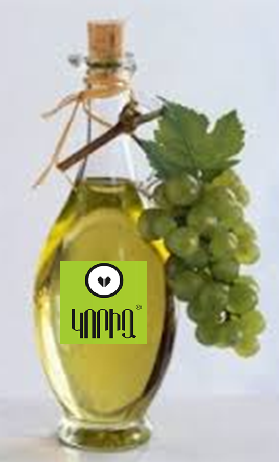Yerevan,
Arin Berd 5th ,
Number 1
094 01 71 01
091 48 54 41
Coreese:
Quin
of vegitable
oils

The Greek
and Armenian
legends and
the Bible
mentions that
the
grape
was the first
plant that
God created
food for people.
Walking
in the
territory of Mets
Hayk, getting
down from
the mountain
Korikum in
Kilikia, Noah
heard from
people that
a goat he released
from the
ark became
very strong
and powerful and
terrifying
all
animals including
wild cats
and Lions. All
animals were
complaining that
the goat does
not allow them
to live in
peace. Noah
finds out that
the goat eats
grape seeds
every day,
which makes
him
to get
strong and
powered. Realizing
the situation
Noah together
with his suns
planted a large
vine yard
in Ararat Valley.
Later he
and
all other people
were getting
vine and juice
out of grape
and
vegetable oil
out of grape
seeds. He was
advising all
people to eat
at
least 21
seeds each
day to get
healthy, as well
as use the oil
to cook
and
make salads.
Although grapeseed oil can have a slight grape flavoring, most varieties have a neutral taste that is non-nutty and non-greasy. Unlike some other oils, grapeseed oil won't turn cloudy if it's chilled. Because of its light, neutral taste, grapeseed oil is ideal for use in tossed salads, and can easily be substituted for olive oil. Grapeseed oil is also well suited for baking; when baking bread, use a pastry brush to apply a thin coating of grape seed oil on unbaked bread, which will give bread a brown, crispy crust when cooked. For added family fun, enlist your child to help "paint" the oil on the bread before it goes in the oven. Frying Grapeseed oil is ideal for pan frying because of its high smoke point. Because grapeseed oil doesn't begin to smoke until 420 degrees Fahrenheit, it can safely be used to cook at high temperatures. Virgin olive oil and peanut oil also have similarly high smoke points, so grapeseed oil can be substituted for both of these oils when frying. The clean, light taste of grapeseed oil, coupled with its high smoke point, makes it ideal for sauteing and stir-frying. Cold Pressing Cold pressing involves applying considerably less pressure in comparison to expeller pressing. As a result, the temperatures associated with cold pressing are much lower, ranging between 120 and 160 degrees F. The main benefit of cold pressing is that its lower temperatures leave more nutrients and flavor intact. Cold-pressed cooking oils have higher quantities of vitamin E, minerals and phosphatides in comparison to expeller-pressed cooking oils.
Cold pressed grapeseed oil is high in bioflavanoids, and antioxidants; and is a rich source of Vitamin E. It is one of the best sources of linoleic acid -- one of the essential fatty acids the body cannot produce. Grapeseed oil contains powerful antioxidants to protect against heart disease and free radical damage, and can assist in lowerering cholesterol. Grapeseed oil has a mild, clean, neutral flavour that is slightly nutty. It has the lowest saturated fat content of any oil and emulsifies really well, making it deal for use in home made salad dressings; and in home made condiments, such as mayonnaiseand aoli. I also like to use it to start a lot of my vegan soups and vegetarian stir-fries. Grapeseed oil is a fantastic substitute for butter in gluten free baked recipes. Most of my recipes are dairy free. But I do use a bit of organic butter in some gluten free cakes, pies and muffins. I will offer grapeseed oil as a substitute in order to make these recipes dairy free where appropriate.
But please note that it will change the personality of the dish. it has been my experience that grapeseed oil alters the cooking time, with the tops of cakes browning a lot quicker. The final product tastes a lot milder too. Often, you will need to add more sweetener, and possibly a little more of the other flavourings, in order to balance out the flavour blend. You will also need to lower the temperature of the oven slightly. But I will usually mention what has worked in my recipe trials. Grapseed oil is also fantastic for natural moisturizer for your skin. With its high Vitamin E content, it is a great carrier oil for use in aromatherapy blends. Please be careful when purchasing grapeseed oil. The wine grapes yield a small amount of oil; and so a lot of oil is chemically extracted, with added stabilizers. Look for cold pressed pure grapeseed oil at the health food store. A note to people with allergies to canola, soy, and sunflower oil: you may also be allergic to grapeseed oil. If you have severe food allergies, please consult your allergist before indulging in grapeseed oil.






